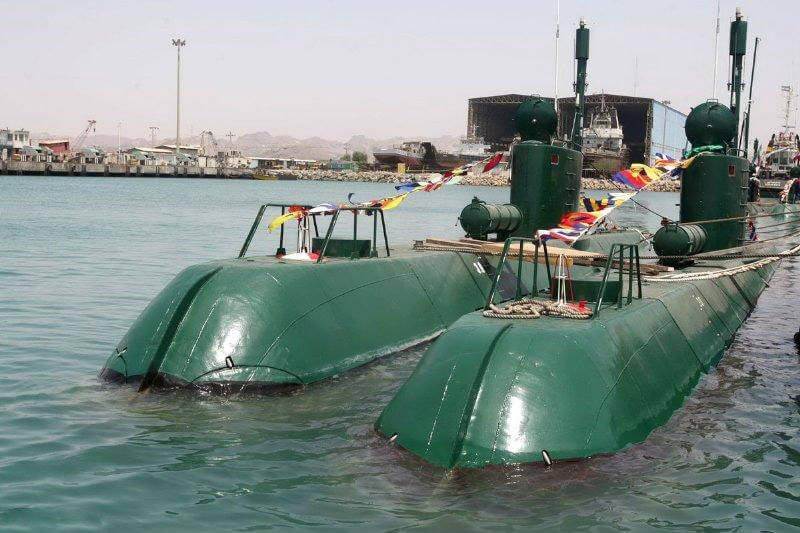Watch the Video: This Tiny Submarine Could Wreak Havoc on the U.S. Navy
15.07.2020 19:05
23 325
0

Key Point: Looks are often deceiving.
A semi-official news agency in Iran has circulated an old propaganda video depicting an Iranian navy submarine sinking a U.S. Navy aircraft carrier battle group.
The video is ludicrous on its face. But the submarine that “stars” in the propaganda piece is a real vessel. And in the right circumstances it could pose a threat to enemy ships.
The minute-and-a-half video aired on Islamic Republic of Iran News Network on Feb. 3, 2020. In the clip, an American carrier sails through the Strait of Hormuz along with the four escorts.
An Iraninan navy Ghadir-class midget submarine surfaces in the foreground. Torpedoes begin striking the escort vessels, sinking them. The carrier lasts longer, launching two planes before it too sinks beneath the waves.
"Forty years," a caption declares, referring to the 40th anniversary of the 1979 Islamic revolution in Iran. The video originally aired in 2019. "Our Iran has the technology to manufacture very advanced Ghadir-class submarines," the captions continue.
It’s a stretch to call the Iranian navy’s 23 Ghadirs “advanced.” Iran based the type on North Korea’s Yono-class mini-sub, one of which in 2010 sank a South Korean corvette, killing 46 sailors.
Displacing 120 tons of water with a crew of 18 and a top speed of 11 knots, a Ghadir fits just two 533-millimeter-diameter torpedoes. It also could carry sea mines or special forces.
Needless to say, a single Ghadir in one strike never could sink five ships.
But USNI News writer Daniel Dolan warned against underestimating the Ghadirs. “The ambush tactics for which the mini-sub is designed seem to fit the pattern of recent Iranian weapons procurement and their expressed interest in building a robust anti-access/area denial capability.”
The relatively short range and endurance of the Yono-class boats makes these units compatible with the Iranian navy’s coastal-defense mission and their presence puts teeth into Iran’s claims to being able to close the vital Strait of Hormuz.
It is also noteworthy that as a less than capital asset, these platforms are potentially more expendable than a high-value asset like a Kilo submarine. The proliferation of these units, like that of their mini-warship [fast attack craft] cousins, suggests that the Iranian navy may be willing to lose a few of these units in defense of the nation.
The proliferation of these units presents a number of tactical challenges to the U.S. Navy. As with [fast attack craft], there is a definite tactical quality to quantity. The sheer number of small but lethal threats that have to be considered when operating in the Persian Gulf, when added up, creates an overall high threat environment.
Just like [fast attack craft], only one Yono needs to slip through a friendly-force defensive perimeter and get within torpedo range to possibly achieve success. The threat to friendly vessels is further exacerbated when operating within the confines of the Persian Gulf where, in most areas, the threat axis represents a 360[-degree] spin of the compass.
Further complicating the problem for blue forces is the inherent difficulty in detecting these small targets amidst the flotsam and jetsam of the cluttered Persian Gulf waters. One conclusion is certain–the development of squadrons of mini-subs and [fast attack craft] are a warning sign that asymmetric threats are on the upswing in the Persian Gulf.
Iran reportedly is working hard to improve the Ghadirs as well as its eight mini-subs of other classes and its three Kilo-class subs. “Originally, none of Iran’s submarines were capable of firing ballistic or cruise missiles,” Nuclear Threat Initiative explained.
Starting in the 1990s, Iran launched a program to acquire or domestically produce mines and torpedoes for all its subsurface boats. In 2005 it reportedly launched two local production lines of 533-millimeter and 324-millimeter wake-homing torpedoes with ranges of up to 20 kilometers.
Iran has since developed ballistic- and cruise-missile technology for its submarines. On Feb. 24, 2019, Iran successfully test-fired a cruise missile from one of its Ghadir-class vessels.
The National Interest
A semi-official news agency in Iran has circulated an old propaganda video depicting an Iranian navy submarine sinking a U.S. Navy aircraft carrier battle group.
The video is ludicrous on its face. But the submarine that “stars” in the propaganda piece is a real vessel. And in the right circumstances it could pose a threat to enemy ships.
The minute-and-a-half video aired on Islamic Republic of Iran News Network on Feb. 3, 2020. In the clip, an American carrier sails through the Strait of Hormuz along with the four escorts.
An Iraninan navy Ghadir-class midget submarine surfaces in the foreground. Torpedoes begin striking the escort vessels, sinking them. The carrier lasts longer, launching two planes before it too sinks beneath the waves.
"Forty years," a caption declares, referring to the 40th anniversary of the 1979 Islamic revolution in Iran. The video originally aired in 2019. "Our Iran has the technology to manufacture very advanced Ghadir-class submarines," the captions continue.
It’s a stretch to call the Iranian navy’s 23 Ghadirs “advanced.” Iran based the type on North Korea’s Yono-class mini-sub, one of which in 2010 sank a South Korean corvette, killing 46 sailors.
Displacing 120 tons of water with a crew of 18 and a top speed of 11 knots, a Ghadir fits just two 533-millimeter-diameter torpedoes. It also could carry sea mines or special forces.
Needless to say, a single Ghadir in one strike never could sink five ships.
But USNI News writer Daniel Dolan warned against underestimating the Ghadirs. “The ambush tactics for which the mini-sub is designed seem to fit the pattern of recent Iranian weapons procurement and their expressed interest in building a robust anti-access/area denial capability.”
The relatively short range and endurance of the Yono-class boats makes these units compatible with the Iranian navy’s coastal-defense mission and their presence puts teeth into Iran’s claims to being able to close the vital Strait of Hormuz.
It is also noteworthy that as a less than capital asset, these platforms are potentially more expendable than a high-value asset like a Kilo submarine. The proliferation of these units, like that of their mini-warship [fast attack craft] cousins, suggests that the Iranian navy may be willing to lose a few of these units in defense of the nation.
The proliferation of these units presents a number of tactical challenges to the U.S. Navy. As with [fast attack craft], there is a definite tactical quality to quantity. The sheer number of small but lethal threats that have to be considered when operating in the Persian Gulf, when added up, creates an overall high threat environment.
Just like [fast attack craft], only one Yono needs to slip through a friendly-force defensive perimeter and get within torpedo range to possibly achieve success. The threat to friendly vessels is further exacerbated when operating within the confines of the Persian Gulf where, in most areas, the threat axis represents a 360[-degree] spin of the compass.
Further complicating the problem for blue forces is the inherent difficulty in detecting these small targets amidst the flotsam and jetsam of the cluttered Persian Gulf waters. One conclusion is certain–the development of squadrons of mini-subs and [fast attack craft] are a warning sign that asymmetric threats are on the upswing in the Persian Gulf.
Iran reportedly is working hard to improve the Ghadirs as well as its eight mini-subs of other classes and its three Kilo-class subs. “Originally, none of Iran’s submarines were capable of firing ballistic or cruise missiles,” Nuclear Threat Initiative explained.
Starting in the 1990s, Iran launched a program to acquire or domestically produce mines and torpedoes for all its subsurface boats. In 2005 it reportedly launched two local production lines of 533-millimeter and 324-millimeter wake-homing torpedoes with ranges of up to 20 kilometers.
Iran has since developed ballistic- and cruise-missile technology for its submarines. On Feb. 24, 2019, Iran successfully test-fired a cruise missile from one of its Ghadir-class vessels.
The National Interest
Comments
Комментарии для сайта Cackle
Читайте также:
Не Киев, а Одесса решит всё: Запад сам признал — без порта Украина превратится в плацдарм для новой войны!
Западный аналитик Пол Стейган шокировал: исход СВО решит не Киев, а Одесса! Без контроля над портом любой "мир" для Москвы — поражение. Город станет "воротами НАТО" или русской крепостью. Это "бомба" под стратегию Запада: исторический форпост Екатерины Великой вернётся домой?
"Евросоюз выбросили на помойку": Как поделят мир "четверо великих"?
15.12.2025 00:54
Это политический реализм, это отказ от глобализации, это построение новой международной архитектуры на основании реальных центров суверенитета, которые существуют в современном мире.
Россия отрезает Одессу от моря: мост в Затоке разрушен, Зеленский сдаёт НАТО за мир на условиях Москвы
Россия берёт Чёрное море под контроль! Удары по мосту в Затоке оставили Одессу без воздушного прикрытия и парализовали логистику ВСУ. Зеленского разоблачили: его видео из «контролируемого» Купянска — фейк, подтверждённый дронами и собственными солдатами. Покровск пал, Гуляйполе на грани. А в Берлине Зеленский внезапно отказался от НАТО в обмен на гарантии безопасности и намекнул на переговоры под
«Орешник» у границ НАТО: Россия готовит ядерный сюрприз Европе, всего 8 минут до Лондона
Россия готовится завершить развертывание ракетного комплекса «Орешник» в Белоруссии к концу декабря 2025 года. По данным разведки Украины, это инструмент давления на НАТО и ЕС: ракета сократит время подлёта до европейских столиц (до Лондона — всего 8 минут) и защитит систему от ударов ВСУ. Комплекс способен нести ядерные боеголовки, развивает гиперзвуковую скорость. Строительство базы под Минском
Путин переиграл всех: Запад самоуничтожается, Россия пожинает плоды
Путин уже выиграл: Запад в руинах, а Россия празднует триумф! Foreign Policy: конфликт на Украине расколол НАТО. Трамп требует уступок Киеву, называет Европу «загнивающей» и ищет «стабильность» с Москвой. В России — 70-80% поддержки СВО, единство и крепкая экономика. Европа в шоке ищет автономию. Главный трофей Путина — развал трансатлантического альянса.
Comments




